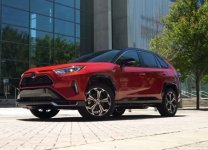It sounds like you're gathering information or considering the pros and cons of plug-in hybrid vehicles (PHEVs). Here's a breakdown of these points, which can help you weigh the decision more carefully:
1. Battery Degradation: The Hidden Cost of Going Electric
Like fully electric vehicles, PHEVs have batteries that degrade over time. This can reduce the electric range and efficiency, particularly in extreme temperatures or with frequent fast charging. Battery replacement can be costly and affect long-term ownership.

2. Fuel Efficiency Variability: The Double-Edged Sword of a PHEV
PHEVs offer great fuel efficiency when using electric power, but once the battery depletes, they often rely on gasoline. The transition between the two modes can result in unpredictable fuel efficiency. Some owners may find their PHEVs don’t deliver the fuel savings they expected, especially for long trips.
3. Limited Electric Range: Is It Enough for Your Daily Commute?
Many PHEVs have an electric range between 20-50 miles. While this is enough for short commutes, it might not be sufficient for those who drive longer distances. After the battery runs out, the car switches to its internal combustion engine, which can feel like a compromise for people seeking to reduce emissions or fuel costs.
4. Environmental Impact: Are PHEVs as Green as They Seem?
While PHEVs are often marketed as eco-friendly, they are not as green as fully electric vehicles (EVs). The production of both a combustion engine and an electric drivetrain increases the carbon footprint. Additionally, if charged using electricity generated from fossil fuels, the environmental benefits diminish.
5. Weight and Performance Trade-offs: Is Your PHEV a Heavyweight Champion or a Burden?
PHEVs carry two powertrains (an electric motor and a combustion engine), which increases the overall weight of the vehicle. This extra weight can negatively impact handling, acceleration, and fuel efficiency when running on gasoline. The weight may also wear out tires and brakes faster.
6. Complexity and Maintenance Costs—Are You Up for the Challenge?
The dual powertrains add complexity to the vehicle, increasing the chances of things going wrong. While pure EVs have fewer moving parts, PHEVs require maintenance for both the electric motor and the internal combustion engine. This could lead to higher long-term maintenance costs.
7. Limited Model Availability—Can You Find Your Ideal PHEV?
Though PHEVs are gaining popularity, the selection is still more limited compared to traditional gas-powered cars or fully electric vehicles. Depending on your preferences, you may find fewer options in terms of style, size, or performance.
8. Charging Infrastructure—Are You Ready for the Charging Routine?
Like fully electric vehicles, PHEVs require charging to take full advantage of their benefits. If you don't have convenient access to charging at home or work, you may find yourself relying more on the gasoline engine, which defeats the purpose of having a PHEV.
9. Charging Habits—Can You Adapt to the PHEV Lifestyle?
PHEVs require regular charging to maximize their fuel-saving potential. Adapting to this routine can be challenging for those who are used to the convenience of refueling at gas stations. If you forget to charge, the car’s gasoline engine will kick in more often, which may negate the environmental and cost-saving benefits.
10. Resale Value—How Will Your PHEV Hold Up?
PHEVs generally have lower resale values compared to traditional gasoline cars and fully electric vehicles. Battery health, government incentives, and advancements in EV technology may also affect the future value of your PHEV.
Conclusion: Is a PHEV Right for You?
Whether a PHEV is right for you depends on your driving habits, access to charging infrastructure, and how much you value the flexibility of having both electric and gasoline power. They can offer the best of both worlds but come with compromises in terms of complexity, maintenance, and environmental impact.
Would you like more detailed information on any of these aspects, or are you considering a specific model?
Youtube
1. Battery Degradation: The Hidden Cost of Going Electric
Like fully electric vehicles, PHEVs have batteries that degrade over time. This can reduce the electric range and efficiency, particularly in extreme temperatures or with frequent fast charging. Battery replacement can be costly and affect long-term ownership.

2. Fuel Efficiency Variability: The Double-Edged Sword of a PHEV
PHEVs offer great fuel efficiency when using electric power, but once the battery depletes, they often rely on gasoline. The transition between the two modes can result in unpredictable fuel efficiency. Some owners may find their PHEVs don’t deliver the fuel savings they expected, especially for long trips.
3. Limited Electric Range: Is It Enough for Your Daily Commute?
Many PHEVs have an electric range between 20-50 miles. While this is enough for short commutes, it might not be sufficient for those who drive longer distances. After the battery runs out, the car switches to its internal combustion engine, which can feel like a compromise for people seeking to reduce emissions or fuel costs.
4. Environmental Impact: Are PHEVs as Green as They Seem?
While PHEVs are often marketed as eco-friendly, they are not as green as fully electric vehicles (EVs). The production of both a combustion engine and an electric drivetrain increases the carbon footprint. Additionally, if charged using electricity generated from fossil fuels, the environmental benefits diminish.
5. Weight and Performance Trade-offs: Is Your PHEV a Heavyweight Champion or a Burden?
PHEVs carry two powertrains (an electric motor and a combustion engine), which increases the overall weight of the vehicle. This extra weight can negatively impact handling, acceleration, and fuel efficiency when running on gasoline. The weight may also wear out tires and brakes faster.
6. Complexity and Maintenance Costs—Are You Up for the Challenge?
The dual powertrains add complexity to the vehicle, increasing the chances of things going wrong. While pure EVs have fewer moving parts, PHEVs require maintenance for both the electric motor and the internal combustion engine. This could lead to higher long-term maintenance costs.
7. Limited Model Availability—Can You Find Your Ideal PHEV?
Though PHEVs are gaining popularity, the selection is still more limited compared to traditional gas-powered cars or fully electric vehicles. Depending on your preferences, you may find fewer options in terms of style, size, or performance.
8. Charging Infrastructure—Are You Ready for the Charging Routine?
Like fully electric vehicles, PHEVs require charging to take full advantage of their benefits. If you don't have convenient access to charging at home or work, you may find yourself relying more on the gasoline engine, which defeats the purpose of having a PHEV.
9. Charging Habits—Can You Adapt to the PHEV Lifestyle?
PHEVs require regular charging to maximize their fuel-saving potential. Adapting to this routine can be challenging for those who are used to the convenience of refueling at gas stations. If you forget to charge, the car’s gasoline engine will kick in more often, which may negate the environmental and cost-saving benefits.
10. Resale Value—How Will Your PHEV Hold Up?
PHEVs generally have lower resale values compared to traditional gasoline cars and fully electric vehicles. Battery health, government incentives, and advancements in EV technology may also affect the future value of your PHEV.
Conclusion: Is a PHEV Right for You?
Whether a PHEV is right for you depends on your driving habits, access to charging infrastructure, and how much you value the flexibility of having both electric and gasoline power. They can offer the best of both worlds but come with compromises in terms of complexity, maintenance, and environmental impact.
Would you like more detailed information on any of these aspects, or are you considering a specific model?
Youtube
